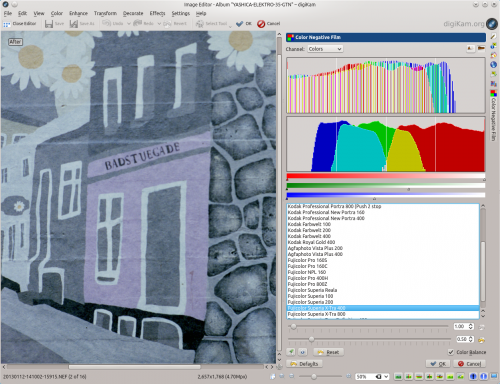Digikam/Negatives/ca: Difference between revisions
Created page with "Mentre que '''digiKam''' és sobretot una aplicació per al processament i organització de fotografies digitals, també compta amb eines per a treballar amb els negatius." |
Created page with "Abans de poder processar negatius en '''digiKam''', cal digitalitzar-los. Si no teniu accés a un escàner de pel·lícules o un laboratori que ofereixi serveis d'escanejat, l..." |
||
| Line 6: | Line 6: | ||
Mentre que '''digiKam''' és sobretot una aplicació per al processament i organització de fotografies digitals, també compta amb eines per a treballar amb els negatius. | Mentre que '''digiKam''' és sobretot una aplicació per al processament i organització de fotografies digitals, també compta amb eines per a treballar amb els negatius. | ||
Abans de poder processar negatius en '''digiKam''', cal digitalitzar-los. Si no teniu accés a un escàner de pel·lícules o un laboratori que ofereixi serveis d'escanejat, la podeu digitalitzar amb una càmera rèflex digital (a la web hi ha un munt de guies d'aprenentatge sobre com fer-ho). La resta del procés se suposa que utilitzeu la darrera manera per a digitalitzar els negatius. | |||
Open a RAW file containing a film negative in the editor (choose <menuchoice>Tools -> Image Editor</menuchoice> or press <keycap>F4</keycap>). Crop the original file and apply lens correction if necessary. Choose then <menuchoice>Color -> Invert</menuchoice> to transform the negative into a positive image. In case you work with the color negative, the converted image most likely requires some additional tweaking. First of all, the converted image is likely to have a strong blue tint. The easiest way to remove it is to use '''digiKam’s''' Auto-Correction tool. Choose <menuchoice>Color -> Auto-Correction</menuchoice> and select one of the presets. In many cases, the <menuchoice>Auto Levels</menuchoice> or <menuchoice>Equalize</menuchoice> presets do a decent job of correcting the colors. If the colors still look slightly off, you can adjust them further using the <menuchoice>Colors -> Color Balance</menuchoice> tool. | Open a RAW file containing a film negative in the editor (choose <menuchoice>Tools -> Image Editor</menuchoice> or press <keycap>F4</keycap>). Crop the original file and apply lens correction if necessary. Choose then <menuchoice>Color -> Invert</menuchoice> to transform the negative into a positive image. In case you work with the color negative, the converted image most likely requires some additional tweaking. First of all, the converted image is likely to have a strong blue tint. The easiest way to remove it is to use '''digiKam’s''' Auto-Correction tool. Choose <menuchoice>Color -> Auto-Correction</menuchoice> and select one of the presets. In many cases, the <menuchoice>Auto Levels</menuchoice> or <menuchoice>Equalize</menuchoice> presets do a decent job of correcting the colors. If the colors still look slightly off, you can adjust them further using the <menuchoice>Colors -> Color Balance</menuchoice> tool. | ||
Revision as of 18:00, 21 February 2013
Processar negatius de pel·lícula amb digiKam
Transcrit des de l'article d'en Dmitri Popov, el 29 de gener de 2013
Mentre que digiKam és sobretot una aplicació per al processament i organització de fotografies digitals, també compta amb eines per a treballar amb els negatius.
Abans de poder processar negatius en digiKam, cal digitalitzar-los. Si no teniu accés a un escàner de pel·lícules o un laboratori que ofereixi serveis d'escanejat, la podeu digitalitzar amb una càmera rèflex digital (a la web hi ha un munt de guies d'aprenentatge sobre com fer-ho). La resta del procés se suposa que utilitzeu la darrera manera per a digitalitzar els negatius.
Open a RAW file containing a film negative in the editor (choose or press F4). Crop the original file and apply lens correction if necessary. Choose then to transform the negative into a positive image. In case you work with the color negative, the converted image most likely requires some additional tweaking. First of all, the converted image is likely to have a strong blue tint. The easiest way to remove it is to use digiKam’s Auto-Correction tool. Choose and select one of the presets. In many cases, the or presets do a decent job of correcting the colors. If the colors still look slightly off, you can adjust them further using the tool.

The Invert feature in combination with an Auto-Correct preset provides a quick-and-dirty way of converting negatives, but digiKam has another tool designed specifically for processing color negatives. To access it, choose the command. The Color Negative Film interface contains several handy features that can help you to convert the negative and tweak the resulting image. While the Invert tool uses a generic profile for converting negatives, the Color Negative Film interface offers film profiles for many popular film types. So the first step is to select the appropriate profile. For better results, try to enable the option, too. If the used film is not in the list, you can use the profile as a fall back.
Although choosing the matching film profile may yield a better result, the converted image may still require some work. In most cases, you may need to adjust the white point to remove the remaining blue tint. You can do this either manually or automatically using the appropriate buttons. Usually, the automatic white point adjustment does the job, but the resulting image needs to be brightened up by adjusting the slider.
